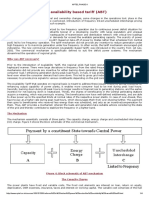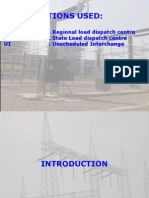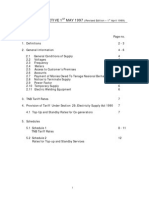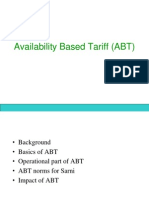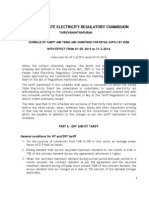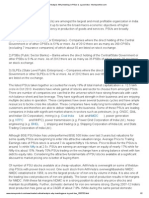Implementation of ABT (Availability Based Tariff) - Its Treatment & Proceedings
Implementation of ABT (Availability Based Tariff) - Its Treatment & Proceedings
Uploaded by
laloo01Copyright:
Available Formats
Implementation of ABT (Availability Based Tariff) - Its Treatment & Proceedings
Implementation of ABT (Availability Based Tariff) - Its Treatment & Proceedings
Uploaded by
laloo01Original Description:
Original Title
Copyright
Available Formats
Share this document
Did you find this document useful?
Is this content inappropriate?
Copyright:
Available Formats
Implementation of ABT (Availability Based Tariff) - Its Treatment & Proceedings
Implementation of ABT (Availability Based Tariff) - Its Treatment & Proceedings
Uploaded by
laloo01Copyright:
Available Formats
National Conference on Recent Trends in Engineering & Technology
Implementation of ABT (Availability Based Tariff) - its Treatment & Proceedings
Shivani Sharma
PhD Scholar, Electrical Engineering Department, SICART, Vallabh Vidhyanagar, Gujarat. sharmapshivani@gmail.com
Prof. (Dr). B.R. Parekh
Prof. & Head, Electrical Engineering Department, BVM Engineering College, Vallabh Vidhyanagar, Gujarat. brp_bvm@yahoo.co.in
AbstractThis paper gives an insight into the various aspects of ABT and its implementation. It covers he salient features of ABT, requirement for day ahead, real time scheduling and operation in ABT Regime. Also the concerns regarding implementation of ABT and the impact on various industry players is being dealt with. The implementation of ABT though complex, shall bring about an immense improvement in grid discipline. Keywords-component: ABT (Availability Based Tariff), Real Time Scheduling,
availability in the present context could be defined as the MW capability of the generator for supplying to the grid after accounting for the planned and unplanned outages and deration due to non-availability of auxiliaries, fuel and water. Availability = Summation of DC over the Day x 100 DC corresponding to Rating PLF= Generation for the Period x 1000 x 100 MW x No. of hours in the period The predecessor was Two part tariff (K P Rao formula) that was applicable for central generating stations, wherein there was no inbuilt mechanism for frequency control. K P Rao Tariff did not seem to encourage grid discipline as there were Conflicting commercial interest in the tariff structureSEBs/CGs, absence of peak off-peak tariff and lack of TOD metering. The possible remedies thought were Incentivize generation so that generators are available for scheduling and despatch, particularly during peak hours, Incentivize generators to back down during off- peak hours, Load curtailment during low frequency, Independent pool operator for scheduling, monitoring, documentation, system operation etc. & Penalties for deviation The central government had been examining the reform of the tariff structure of bulk power with objective: Inducing better system operation and grid discipline Through commercial incentives and dis-incentives.
I.
INTRODUCTION
The electricity industry in India is facing a lot of challenges. They range from inadequate capacities in generation, transmission, and distribution, outdated technologies especially in T&D, poor maintenance, financial constraints, etc. As per the Regulatory Commissions Act 1998, the Central Electricity Regulatory Commission (CERC) is authorized to regulate bulk electric power tariffs, viz. the tariff for generation and transmission of power. This will promote competition thereby improving operational efficiency and safeguarding consumer interests. The ABT mechanism is based on the financial principals, wherein all the Central Sector generators and beneficiaries (i.e., various States) must declare a schedule for generation and drawal for every 15 minutes one day in advance. Any deviation from the schedule is charged at the rates, which are frequency dependent. Previously, before implementation of ABT, there was frequent problem of power overdrawal from one of the State beneficiaries, leading to the grid instability. But the new frequency based tariff has brought lot of grid discipline. Still this inter-State ABT is a partial solution of the problem because currently there is a huge amount of peak power shortage experienced by majority of the State utilities. In addition to this the transmission corridors are getting congested while bringing the excess amount of power from the remote location to the load centers. Availability means the readiness of the generating station to deliver Ex. Bus output expressed as a percentage of its rated Ex. Bus output capability as per rated capacity. The term
New Tariff Mechanism ABT was introduced through CERC order on Availability Based Tariff dated. 04.01.2000. [1] II. SALIENT FEATURES OF ABT
There are three components of availability based tariff
13-14 May 2011
B.V.M. Engineering College, V.V.Nagar,Gujarat,India
National Conference on Recent Trends in Engineering & Technology
Capacity charges (fixed cost): Full recovery at normative availability, Apportioned to various beneficiaries as per allocation Energy charge: Upto scheduled energy, At normative tariff Unscheduled interchange (UI):Deviation from schedule, Rate linked to frequency; different UI charts over time energy drawal. Capacity charges are paid to generators based on the declared availability of the generator irrespective of the actual generation. Variable charges are being paid to the generators based on the scheduled energy instead of the actual energy drawn by the beneficiaries. Any deviation from the schedule generation/drawal are subject to unscheduled interchanges at a rate depending on the average grid frequency during each time block. [2] Fig 1 denotes a typical UI Vector. Each 0.02 Hz. step is equivalent to 15.5 p/Kwh in the 50.2-49.7 Hz. freq. range and 47 p/Kwh in the 49.68-49.5 Hz. freq. range.
TABLE I. TYPICAL AVERAGE FREQUENCY AND UI RATES
Here 100% generation capacities of a ISGS is allocated to beneficiaries. Fixed cost recovery is as per entitlement of individual beneficiaries (irrespective of drawal by the SEB) & calculated on annual basis. SEBs are scheduled for drawal from ISGS, based upon their requisition, limited to their entitlement. Variable charge recovery is as per norms for only scheduled energy. Norms of fixed and variable charge are declared stationwise periodically by CERC in their tariff regulation. Present Tariff Period of 2004-09. UI charges are levied for difference in its Actual and Scheduled Generation/drawal. UI will be worked out for each 15 minutes time block. Charges for UI are frequency linked and are payable/ recoverable depending on grid frequency if: A generator generates more than schedule Gets UI A generator generates less than the schedule - Pays UI A beneficiary overdraws power - Pays UI A beneficiary under draws power Gets UI
AVERAGE AVERAGE AVERAGE FREQUENCY OF FREQUENCY OF UI RATE UI RATE FREQUENCY OF UI RATE TIME BLOCK TIME BLOCK TIME BLOCK (HZ.) W.E.F W.E.F W.E.F (HZ.) (HZ.) 01.05.2010 01.05.2010 01.05.2010 (PAISA / (PAISA / (PAISA / NOT NOT NOT KWH) KWH) KWH) BELOW BELOW BELOW BELOW BELOW BELOW 50.20 50.20 50.18 50.16 50.14 50.12 50.10 50.08 50.06 50.04 50.02 50.00 49.98 49.96 50.18 50.16 50.14 50.12 50.10 50.08 50.06 50.04 50.02 50.00 49.98 49.96 49.94 0.00 15.50 31.00 46.50 62.00 77.50 93.00 108.50 124.00 139.50 155.00 170.50 186.00 201.50 49.94 49.92 49.90 49.88 49.86 49.84 49.82 49.80 49.78 49.76 49.74 49.72 49.70 49.68 49.92 49.90 49.88 49.86 49.84 49.82 49.80 49.78 49.76 49.74 49.72 49.70 49.68 49.66 217.00 232.50 248.00 263.50 279.00 294.50 310.00 325.50 341.00 356.50 372.00 387.50 403.00 450.00 Each 0.02 Hz. step is equivalent to 15.5 p/Kwh in the 50.2-49.7 Hz. freq. range and 47 p/Kwh in 49.749.5 Hz. freq. range (Applicable w.e.f 03.05.2010) 49.66 49.64 49.62 49.60 49.58 49.56 49.54 49.52 49.50 49.64 49.62 49.60 49.58 49.56 49.54 49.52 49.50 497.00 544.00 591.00 638.00 685.00 732.00 779.00 826.00 873.00
Commercial mechanism contemplates equal treatment to all the participants and a self-imposed discipline. For introducing grid discipline, the concept of unscheduled interchange (UI) has been introduced. The amount of generation by ISGS or drawal by constituents, which deviates from schedule is unscheduled interchange. UI is payable or receivable depending on over or under generation. Rate of UI linked to average frequency of 15 minutes time block.
UI is being treated as a grid disciplining mechanism. For stations using Coal/ Lignite/ APM gas; UI payable and receivable to be capped at rate corresponding to 49.70- 49.68 Hz. For over-injection by a generating station beyond 105% (101% in a day)- UI receivable to be capped at rate corresponding to 50.02- 50.0 Hz. CERC may on suo-motu or on a petition by RLDC proceed against generating station for Gaming defined as intentional mis-declaration for undue commercial gains, on investigation if found gaming, UI payable shall be made zero. Volume limits on UI below 49.7 Hz is as follows: Over-drawal by buyers/ beneficiaries: 12% of SD in a block (Max 150 MW) & (3% over a day for all blocks when f < 49.7 Hz). Underinjection by buyers/ beneficiaries: 12% of SG in a block & (3% over a day for all blocks when f < 49.7 Hz).
Fig. 1: A typical UI Vector
Capacity charges paid by customers are based on capacity allocation instead of earlier system of payment based on
13-14 May 2011
B.V.M. Engineering College, V.V.Nagar,Gujarat,India
National Conference on Recent Trends in Engineering & Technology
Additional UI Charges are Payable in addition to applicable UI charges for over-drawal/ under injection of electricity when f < 49.5 Hz, A. Below 49.5 Hz and up to 49.2 Hz Over drawal - 40% of UI rate at 49.5 Hz. = 349.2 p/kWh. Under injection - 20% of UI rate at 49.5 Hz. = 174.6 p/kWh. For Generating station using coal/lignite/APM gas as the fuel - 20% of Cap Rate = 80.6 p/kWh b. b. c. d. e. a. o o o Keeping Accounts of Energy Instructions w.r.t. Real time operation Frequency Management Network Congestion Regional Load Dispatch Centre : Inter-state CGS UMPPs Inter-state Bilateral transactions For all private ISGS of size >500 MW where at least 50% power is allocated outside the home state Intra-state generators IPPs except those above Embedded Open Access customers
Jurisdiction:
B. Below 49.2 Hz Over drawal - 100% of UI rate at 49.5 Hz. = 873 p/kWh. Under injection - 40% of UI rate at 49.5 Hz. = 349.2 p/kWh. For Generating station using coal/lignite/APM gas as the fuel - 40% of Cap Rate = 161.2 p/kWh Shall not be applicable for net over drawls by a region as a whole from other regions when grid frequency is below 49.5 Hz. III. SALIENT FEATURES OF SCHEDULING
State Load Dispatch Centre : a. b. c.
C. Day-Ahead Scheduling Declaration of station-wise capability by ISGS: 09:00 hrs. Advice on entitlements of constituents by RLDC: 1000 hrs. Drawal requisitions and bilateral exchanges by SLDCS to RLDC: 1500 hrs. Announcement of surplus: Dispatch & drawal schedule (1st draft) to each constituent: 1800 hrs. SLDCS/ ISGS may inform changes to their capability/ drawal: 2200 hrs. Final day-ahead schedule: 2300 hrs.
A. Scheduling Terminology IEGC: Indian Electricity Grid Code ISGS: Inter-state Generating Stations RLDC: Regional Load Dispatch Centre SLDC: State Load Dispatch Centre Firm power: upto entitlement Entitlement: varies with declared Maximum of allocated share at 100% dc. Priority in scheduling & accounting: a. b. c. B. Firm power Bilateral power Infirm power-UI capability.
Infirm power: unrequisitioned surplus power & ui.
D. Real Time Scheduling Provisions In ABT Order a. Capability Revision Due To Tripping: In case of forced outage of a unit, RLDC will revise the schedules on the basis of revised declared capability. The revised schedules will become effective from the 4th time block, counting the time block in which the revision is advised by the generator to be the first one. The revised DC will also become effective from the 4th time bock. Revision of Capability/ Requisition: permitted with advance notice. Revised schedules/declared capability in such cases shall become effective from the 6th time block, counting the time block in which the request for revision has been received in RLDC to be the first one.
Scheduling Responsibilities Generators: a. b. c. Communication of Day-ahead capability (DC) Communication of revision of capabilities Adherence to IEGC and directions of LDCs Preparation and communication of Schedules b.
Load Dispatch Centres: a.
13-14 May 2011
B.V.M. Engineering College, V.V.Nagar,Gujarat,India
National Conference on Recent Trends in Engineering & Technology
c. Schedule Revision Due To Transmission Constraints: (As certified by RLDC) necessitating reduction in generation, RLDC will revise the schedules which will become effective from the 4th time block, counting the time block in which the bottleneck in evacuation of power has taken place to be the first one. Also, during the first, second and third time blocks of such an event, the scheduled generation of the station will be deemed to have been revised to be equal to actual generation and also the scheduled drawals of the beneficiaries will be deemed to have been revised to be equal to their actual drawals. Schedule Revision Due To Grid Disturbances: Scheduled Generation of all the Generating Stations and Scheduled Drawal of all the Beneficiaries shall be deemed to have been revised to be equal to their Actual Generation/Drawal for all the time blocks affected by the Grid Disturbance. Certification of Grid Disturbance and its duration shall be done by RLDC. Schedule Revision Due To System Requirement: RLDC observes that there is need for revision of the schedules in the interest of better system operation; it may do so on its own. The revised schedules shall become effective from the 4th time block, counting the time block in which the revised schedule is issued by RLDC to be the first one. Revision of Schedules: Generation schedules and drawal schedules issued/revised by RLDC shall become effective from designated time block irrespective of communication success. [4] d. Peak hour DC should not be less than other periods Stations have installed ABT compliant meters for monitoring and management of ABT performance ABT compliant software IV. CONCERNS ON ABT
Real-time management of ABT performance a.
b.
d.
e.
While ABT is acknowledged to be a welcome measure to tackle the major problems in our power scenario and is expected to be the welcome step towards a self-regulating market, there are a lot of concerns that need to be addressed by this new system. We will, in this document, concern ourselves only with issues of a technical nature and not with those having political or statutory implications (such as whether a particular clause of ABT is within the jurisdiction of CERC). For information regarding these and detailed information on the clauses of ABT, the reader is referred to the full text of the ABT notification. Some of the important technical concerns to be addressed by ABT are: What happens to the schedule and UI charges in instances of the grid disruption beyond the control of generator or consume? ABT delegates the responsibility of resolving such instances to the RLDC. However more clarity needs to be brought forth on this issue as this point can potentially cause a lot of contention regarding the UI charges. A fundamental concern on ABT is whether it is the right measure to be introduced. While the spirit and intention of the act is widely appreciated, there is serious concern that it introduces elaborate and complicated procedures that shall give rise to a lot of contentions between involved parties on their interpretation. Some of these aspects include the declaration and demonstration of availability by a generating station, computation of variable and UI charges, rescheduling of generation and consumption etc. It may be required to evolve the current proposals to a more simplified and transparent system over a period of time. Acceptable availability may vary depending on the energy source of the generating station. And in some cases, such as hydro and wind stations the availability may not be accurately predictable except in the very short term. This will pose problems in calculation of fixed charges based on availability Plants commissioned in different times tend to use vastly varying technology and thus tend to differ a lot in efficiency and cost of production. Since revenue for the generator vary significantly with efficient and controlled operation, old (though fully functional) plants may be at a disadvantage. The investment required to bring them to par with their modern counterparts may not be justified by the professed returns. On the other hand if CERC relents to discriminate between plants based on this
f.
E. Operation In ABT Regime Station to declare day-ahead DC on ex-bus basis to RLDC by 0900 hrs- Station O&E a. b. c. d. e. f. Based on best estimate of availability of units. Realistic APC assessment Availability and quality of fuel Loading limitations & Operational constraintscondenser vacuum, ID Fan margins etc. Peak hour demand This is coordinated through RCC.
Prompt revision of capability in real-time- SCE a. Delay of 15 mins in reporting tripping of 500 MW unit could mean a UI of THE ORDER OF Rs. 10 LAKH Revision based on unit performance and fuel characteristics. Spreading out the generation over the day in case of shortage of fuel
b. c.
13-14 May 2011
B.V.M. Engineering College, V.V.Nagar,Gujarat,India
National Conference on Recent Trends in Engineering & Technology
factor, it will just add to the opacity of the proposed system Another significant concern on ABT is the possibility of gaming (deliberate manipulation of availability, daily demand and capacity schedules etc.) by the involved parties to derive undue benefit from the UI charges. ABT system introduces clauses meant to discourage gaming through severe penalties. Whether this will prove a sufficient enough deterrent and whether the checks and balances prove adequate to detect gaming need to be ascertained Another interesting concern is the CERC that any revision in schedule by the RLDC will deemed to be effective irrespective of the successful communication of the same to concerned parties. As has already been pointed out, most of the concerned parties being PSUs lagging on the technology front are yet to have fool-proof or redundant communication infrastructure in place. Thus rescheduling may fail to reach concerned parties in a timely manner and if somebody is caught unawares on the wrong side of the UI charges, they are not going to be pleased about ABT. [2] V. IMPLICATIONS FOR DIFFERENT INDUSTRY PLAYERS Ushering in of MOD is going to be a positive development for all generators enabling them to make huge savings on cost. All these factors will involve a good amount of technology investment but will set the right background for an efficient power structure and the right launching pad for a market oriented approach. This will naturally result in higher reliability and increased customer confidence giving the right impetus for more industrialization and enhancing our development process. At the consumption end also there is going to be the need to forecast demands as accurately as is possible and to follow the strictest possible grid discipline. This again will prove vastly beneficial to the power industry as a whole. VI. CONCLUSION All the apprehensions regarding the new system notwithstanding, ABT is still a welcome and necessary development. Next step is for the concerned authorities to ensure the necessary infrastructure to remove all the bottlenecks on the transmission side. Once this is done, the path should be clear to a completely market driven scenario with much better systems and infrastructure in place. The culminating point shall be an elaborate and efficient system with much more reliance on distributed power systems as well. This will iron out any monopoly tendencies in the system delivering maximum benefits to the consumers. This will also prove beneficial to the environment since green power norms are much more effectively implemented in a distributed and deregulated power scenario.
Put succinctly ABT requires all the actors in the great power drama to get their technology act right. There is no room for laxity on control or efficiency fronts. The technology dependency is going to be more on the generation side. Capital cost of the generating facility being redeemable only against declared availability and successful demonstration of the same will require the generators to really have a tight rein on their complete infrastructure. All the generators will now need to set a target of 85% availability to ensure that complete capital costs, ROE and incentives are available to them. And the provision for surprise audit to demonstrate the availability will need to them to monitor all the equipments and ensure adequate and timely maintenance of their overall infrastructure. This will usher a modern outlook and calls for the latest and best technology in performance calculations, efficiency and IT. Variable costs and UI charges will require the generators to closely match their output with the demand curve and the ability to take corrective actions in the shortest possible time. ABT also calls for elaborate computation of the payable tariffs and close monitoring of the cost of production.
REFERENCES
[1] [2] Availability Based Tariff order year 2000, Central Electricity Regulatory Commission. http://www.cercind.org/ Introduction to Availability Based Tariff A White Paper Revision 1.0 Version 1.0 Kalki Communication Technologies Private Limited, Bangalore, March 2010. www.cercind.gov.in -Terms and Conditions of Tariff by CERC Central Electricity Regulatory Commission (ABT regulations), 2007 Ujdigispace.uj.ac.za:8080/dspace/bitstream/10210/531/5/03thesis.pdf, Salient Features of Scheduling, University of Johhanesburg., 2003 S.K. Soonee, S.R. Narasimhan and V. Pandey, Significance of Unscheduled Interchange Mechanism in the Indian Electricity Supply Industry, ICPSODR-2006, Dept. of Electrical Engineering, ITBHU Published in Gazette of India The Electricity Act, 2003. India: Universal Law, Publication Company Pvt. Ltd.
[3] [4] [5]
[6]
13-14 May 2011
B.V.M. Engineering College, V.V.Nagar,Gujarat,India
You might also like
- Hydro Tariff DeterminationDocument12 pagesHydro Tariff DeterminationAnonymous sENwj8nwq100% (3)
- Indian Railway Traction Manual For Operation and MaintenanceDocument247 pagesIndian Railway Traction Manual For Operation and MaintenanceChandan Kumar100% (2)
- Practical Guides to Testing and Commissioning of Mechanical, Electrical and Plumbing (Mep) InstallationsFrom EverandPractical Guides to Testing and Commissioning of Mechanical, Electrical and Plumbing (Mep) InstallationsRating: 4 out of 5 stars4/5 (4)
- Chapter 11 Grade 5 Scott Foresman ScienceDocument3 pagesChapter 11 Grade 5 Scott Foresman ScienceasaleemnaNo ratings yet
- Availibilty Based TariffDocument76 pagesAvailibilty Based Tariffsunilmvgr5No ratings yet
- Availablility Based Tariff (ABT) : An OverviewDocument41 pagesAvailablility Based Tariff (ABT) : An OverviewSamNo ratings yet
- Availability Based TariffDocument33 pagesAvailability Based TariffSONAWANE ATUL SANJAYNo ratings yet
- Nptel Phase-II AbtDocument4 pagesNptel Phase-II AbtVenkat Sai ReddyNo ratings yet
- Availability-Based Tariff: Availability Based Tariff (ABT) Is A Frequency Based Pricing Mechanism Applicable inDocument5 pagesAvailability-Based Tariff: Availability Based Tariff (ABT) Is A Frequency Based Pricing Mechanism Applicable inAnujaNo ratings yet
- Generation Tariff - ABTDocument53 pagesGeneration Tariff - ABTAyyappan SubramanianNo ratings yet
- Availability Based Tariff (...Document5 pagesAvailability Based Tariff (...vivekguptagkpNo ratings yet
- ABT BY Abhishek MazumdarDocument74 pagesABT BY Abhishek MazumdarAbhimazumdarNo ratings yet
- ABC of ABT - A Primer On Availability TariffDocument36 pagesABC of ABT - A Primer On Availability TariffcolossalzeeshanNo ratings yet
- Power Sector DevelopmentsDocument12 pagesPower Sector Developmentspabamag01No ratings yet
- Architecture of ABT Optimization Engine For Energy Management SystemDocument5 pagesArchitecture of ABT Optimization Engine For Energy Management SystemRavindra KumarNo ratings yet
- ABC of ABTDocument36 pagesABC of ABTsen_subhasis_58No ratings yet
- Abt Uideviationsettlement 160118081553 PDFDocument42 pagesAbt Uideviationsettlement 160118081553 PDFasura22novNo ratings yet
- CERC (Deviation Settlement Mechanism and Related Matters) Regulations, 2014 Dated 06.01.14Document42 pagesCERC (Deviation Settlement Mechanism and Related Matters) Regulations, 2014 Dated 06.01.14asura22novNo ratings yet
- 21-May-2010 - Presentation On UI Account As Per New GuidelinesDocument37 pages21-May-2010 - Presentation On UI Account As Per New GuidelinesanshumanshrivastavaNo ratings yet
- Availability Based TariffDocument24 pagesAvailability Based Tariffprati121No ratings yet
- Economics of Power GenerationDocument50 pagesEconomics of Power GenerationMukesh SwamiNo ratings yet
- Abbreviations Used:: RLDC: Regional Load Dispatch Centre SLDC: State Load Dispatch Centre UI: Unscheduled InterchangeDocument23 pagesAbbreviations Used:: RLDC: Regional Load Dispatch Centre SLDC: State Load Dispatch Centre UI: Unscheduled Interchangenamanvyas21No ratings yet
- DSM Regulations Npti Webinar FinalDocument48 pagesDSM Regulations Npti Webinar FinalGouravNo ratings yet
- Availability Based Tariff (ABT)Document5 pagesAvailability Based Tariff (ABT)Suvra PattanayakNo ratings yet
- Portal CZ FAQs FAQDocument7 pagesPortal CZ FAQs FAQMaa Vaishno Engineering Co.No ratings yet
- Availability Based TariffDocument10 pagesAvailability Based TariffDaya CheluvaNo ratings yet
- Ui Charges Rates Unsheduled Inter Change ChargesDocument50 pagesUi Charges Rates Unsheduled Inter Change ChargesAnand SwamiNo ratings yet
- Concept of Electrical TarrifsDocument4 pagesConcept of Electrical TarrifsAshutosh SoniNo ratings yet
- TariffDocument12 pagesTariffsiddheshghadi4232No ratings yet
- Availability Based TariffDocument3 pagesAvailability Based Tariffdem rojNo ratings yet
- A Primer On Availability Tariff: Abc of AbtDocument18 pagesA Primer On Availability Tariff: Abc of AbtDev SwainNo ratings yet
- Availability-based Tariff - WikipediaDocument15 pagesAvailability-based Tariff - WikipediavenkeebloreNo ratings yet
- Availability Based Tariff: Pre - ABT RegimeDocument6 pagesAvailability Based Tariff: Pre - ABT RegimeRakesh BabuNo ratings yet
- Latest Commercial AspectsDocument40 pagesLatest Commercial AspectsS K dasNo ratings yet
- 3456Document5 pages3456sushilmeena15072001No ratings yet
- Bhanu Bhushan ArticleDocument26 pagesBhanu Bhushan ArticleKamal KannanNo ratings yet
- NRG Mod3-2Document2 pagesNRG Mod3-2Abhinandh MenonNo ratings yet
- Intra-State Availability Based Tariff (ABT)Document15 pagesIntra-State Availability Based Tariff (ABT)dahigaonkarNo ratings yet
- Central Electricity Regulatory Commission New DelhiDocument11 pagesCentral Electricity Regulatory Commission New DelhiDhiraj SatyamNo ratings yet
- Summary Report For Baba RamdevDocument2 pagesSummary Report For Baba RamdevAmol KambleNo ratings yet
- Availablility Based Tariff (ABT)Document39 pagesAvailablility Based Tariff (ABT)Ruchika BishtNo ratings yet
- Abc of Abt: A Primer On Availability TariffDocument37 pagesAbc of Abt: A Primer On Availability TariffjaveddvcNo ratings yet
- Availability Based TariffDocument23 pagesAvailability Based TariffDevesh RajNo ratings yet
- Recommendations Regarding Implementation of Availability Based Tariff (A.B.T.) in Intra-State SystemsDocument15 pagesRecommendations Regarding Implementation of Availability Based Tariff (A.B.T.) in Intra-State Systemsakshay jawaleNo ratings yet
- Availability Based TariffDocument2 pagesAvailability Based TariffVijaya KumarNo ratings yet
- Final Cost Data Book - 1.4.2010Document46 pagesFinal Cost Data Book - 1.4.2010Jafar AliNo ratings yet
- Indian Power Market, Power Exchange - Bangladesh PerspectiveDocument50 pagesIndian Power Market, Power Exchange - Bangladesh PerspectiveSanuwar RahmanNo ratings yet
- Intra StateabtDocument14 pagesIntra StateabtRaja RamNo ratings yet
- TNB Tariff BookDocument14 pagesTNB Tariff BookRamani KrishnamoorthyNo ratings yet
- Format 16 Guidelines To Consumers1Document18 pagesFormat 16 Guidelines To Consumers1raj sekharNo ratings yet
- Abc AbtDocument37 pagesAbc AbtVarada TambeNo ratings yet
- Availability Based TariffDocument14 pagesAvailability Based Tariffvipulgupta2012No ratings yet
- Electricity TariffDocument34 pagesElectricity Tariffdks12No ratings yet
- Road Map To Developing Ancillary Services ModelDocument7 pagesRoad Map To Developing Ancillary Services ModelHitesh MathurNo ratings yet
- WRLNew-Tariff-MechanismDocument10 pagesWRLNew-Tariff-Mechanismdem rojNo ratings yet
- KSEB TARIFF (01-05-13 To 31-3-14)Document36 pagesKSEB TARIFF (01-05-13 To 31-3-14)vjtheeeNo ratings yet
- Methods for Increasing the Quality and Reliability of Power System Using FACTS DevicesFrom EverandMethods for Increasing the Quality and Reliability of Power System Using FACTS DevicesNo ratings yet
- A Case Study for a Single-Phase Inverter Photovoltaic System of a Three-Bedroom Apartment Located in Alexandria, Egypt: building industry, #0From EverandA Case Study for a Single-Phase Inverter Photovoltaic System of a Three-Bedroom Apartment Located in Alexandria, Egypt: building industry, #0No ratings yet
- Investigation of the Usefulness of the PowerWorld Simulator Program: Developed by "Glover, Overbye & Sarma" in the Solution of Power System ProblemsFrom EverandInvestigation of the Usefulness of the PowerWorld Simulator Program: Developed by "Glover, Overbye & Sarma" in the Solution of Power System ProblemsNo ratings yet
- Broad Status Report: Thermal Power ProjectsDocument120 pagesBroad Status Report: Thermal Power Projectslaloo01No ratings yet
- Uttar Pradesh Caste Certificate - Jati Praman Patra - IndiaFilingsDocument8 pagesUttar Pradesh Caste Certificate - Jati Praman Patra - IndiaFilingslaloo01No ratings yet
- Overhauling Manual PDFDocument118 pagesOverhauling Manual PDFlaloo01100% (1)
- What Is Tertiary Treatment PlantDocument8 pagesWhat Is Tertiary Treatment Plantlaloo01100% (1)
- FOREWORD (NOTIFICATION) - Department of Personnel & TrainingDocument237 pagesFOREWORD (NOTIFICATION) - Department of Personnel & Traininglaloo01No ratings yet
- Brochure and Registration Form of CDM 14-10-15Document5 pagesBrochure and Registration Form of CDM 14-10-15laloo01No ratings yet
- Place Homework Into The Basket. 2. Pick Up Powerpoint GuideDocument51 pagesPlace Homework Into The Basket. 2. Pick Up Powerpoint Guidelaloo01No ratings yet
- Aycl CMDDocument7 pagesAycl CMDlaloo01No ratings yet
- NTPC - Cement Manufacturers AssociationDocument53 pagesNTPC - Cement Manufacturers Associationlaloo01No ratings yet
- Functional Competency Directory FOR Contracts & Material RolesDocument7 pagesFunctional Competency Directory FOR Contracts & Material Roleslaloo01No ratings yet
- CERC Delhi Vacancy28 Last Date Dec 14Document7 pagesCERC Delhi Vacancy28 Last Date Dec 14laloo01No ratings yet
- Chapter Addresses As On 21.11.2015Document2 pagesChapter Addresses As On 21.11.2015laloo01No ratings yet
- Analysis - Why Investing in PSUs Is A Good Idea - MoneycontrolDocument2 pagesAnalysis - Why Investing in PSUs Is A Good Idea - Moneycontrollaloo01No ratings yet
- CPCB Tel Directory 2016Document24 pagesCPCB Tel Directory 2016laloo0150% (2)
- Alstom T&D Bagged Two Contracts of 151 Crore Rupees From GETCODocument1 pageAlstom T&D Bagged Two Contracts of 151 Crore Rupees From GETCOlaloo01No ratings yet
- QCFI Registration Certificate For Chandrapura ThermalDocument1 pageQCFI Registration Certificate For Chandrapura Thermallaloo01No ratings yet
- Sc10 - Worksheet On Atoms and IonsDocument6 pagesSc10 - Worksheet On Atoms and IonsAnmol AgarwalNo ratings yet
- Flyer - Hands On Training On PVsystDocument1 pageFlyer - Hands On Training On PVsystSaurabh AgrawalNo ratings yet
- Letter On Energy Saving and Initiatives For Kumpulan Karangkraf Sdn. Bhd.Document2 pagesLetter On Energy Saving and Initiatives For Kumpulan Karangkraf Sdn. Bhd.El ZharNo ratings yet
- Atomic Structure MCQS: 1 Year N0tes Chemistry NewDocument11 pagesAtomic Structure MCQS: 1 Year N0tes Chemistry NewHaider Jalal93% (15)
- XSteam Excel v2.6Document12 pagesXSteam Excel v2.6Jorge GuillermoNo ratings yet
- Distillation Process CalculationDocument11 pagesDistillation Process CalculationjaffliangNo ratings yet
- Coal Fired Power Plant Termopaipa Iv: Compañía Eléctrica de Sochagota S.A. E.S.PDocument16 pagesCoal Fired Power Plant Termopaipa Iv: Compañía Eléctrica de Sochagota S.A. E.S.PControl Office and Technical Department CESNo ratings yet
- Rooftop Solar - Andhra PradeshDocument5 pagesRooftop Solar - Andhra PradeshJagan Mohan DeshpandeNo ratings yet
- 15eme14 PDFDocument5 pages15eme14 PDFRavichandran GNo ratings yet
- Einstein Photoelectric EffectDocument18 pagesEinstein Photoelectric EffectSukhwinder Singh GillNo ratings yet
- Guideline For The Registration of Energy Service Company Esco PDFDocument3 pagesGuideline For The Registration of Energy Service Company Esco PDFrex100% (1)
- Bab 5 Fonon Dan Vibrasi KristalDocument28 pagesBab 5 Fonon Dan Vibrasi Kristalanon_365815921No ratings yet
- Test Particle PhysicsDocument7 pagesTest Particle PhysicsAhmed HossainNo ratings yet
- TedaDocument30 pagesTedaPrabha KaruppuchamyNo ratings yet
- Topic 8 Property CETDocument28 pagesTopic 8 Property CETNsv Dinesh100% (1)
- Power Sector in India: All You Wanted To Know in 5 PointsDocument7 pagesPower Sector in India: All You Wanted To Know in 5 PointsJay ThakarNo ratings yet
- Ansaldo Thomassen - Gas Turbine Remanufacturing (2014)Document4 pagesAnsaldo Thomassen - Gas Turbine Remanufacturing (2014)guerrez100% (1)
- Cosmic EvolutionDocument56 pagesCosmic EvolutionJeremiah NayosanNo ratings yet
- AST Assignment 4Document4 pagesAST Assignment 4ramiresc76No ratings yet
- Electricity AssignmentDocument5 pagesElectricity Assignmentapi-320629366No ratings yet
- Assignment - Energy Resource Project StudentDocument3 pagesAssignment - Energy Resource Project StudentGaurav GadhesariaNo ratings yet
- Pengenalan Alam SekitarDocument57 pagesPengenalan Alam SekitarZura UmarNo ratings yet
- Practical Cosmology and Cosmological Physics: Yu. Baryshev, I. Taganov, P. TeerikorpiDocument16 pagesPractical Cosmology and Cosmological Physics: Yu. Baryshev, I. Taganov, P. Teerikorpi87871547No ratings yet
- Application Notes - ToRO Hybrid AC - ATM Enclosure CoolingDocument2 pagesApplication Notes - ToRO Hybrid AC - ATM Enclosure CoolingshamkantmNo ratings yet
- Audit Energi Dalam Distribusi Listrik: by PT Karya Energi SejahteraDocument17 pagesAudit Energi Dalam Distribusi Listrik: by PT Karya Energi Sejahterapriyo_a_s100% (1)
- Innovative Measures For Energy Management in Tea IndustryDocument5 pagesInnovative Measures For Energy Management in Tea IndustryRuwan WijemanneNo ratings yet
- Planar Rigid Body Dynamics: Work and EnergyDocument11 pagesPlanar Rigid Body Dynamics: Work and EnergynguyendaibkaNo ratings yet
- Pesco InterviewDocument2 pagesPesco InterviewMoHsin KhNo ratings yet
- The Big Bang - NASA ScienceDocument4 pagesThe Big Bang - NASA ScienceDescartesNo ratings yet







